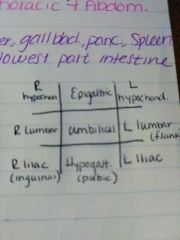![]()
![]()
![]()
Use LEFT and RIGHT arrow keys to navigate between flashcards;
Use UP and DOWN arrow keys to flip the card;
H to show hint;
A reads text to speech;
42 Cards in this Set
- Front
- Back
|
Anatomy |
Study of structure of an organism and relation to its parts |
|
|
Physiology |
Study of functions of living organisms and their parts |
|
|
Pathology |
Scientific study of disease |
|
|
Atoms/molecules |
Chemical level |
|
|
Cells |
Smallest structural units, organization of various chemicals |
|
|
Tissues |
Organization of similar cells |
|
|
Organs |
Organization of different tissues |
|
|
Systems |
Organization of different organs |
|
|
Anatomical position |
Standing erect, feet slightly apart, arms at sides with palms forward |
|
|
Supine |
Laying in back |
|
|
Prone |
Laying on stomach |
|
|
Superior |
Toward head, above |
|
|
Inferior |
Toward feet, below |
|
|
Anterior |
Front (ventral) |
|
|
Posterior |
Back (dorsal) |
|
|
Medial |
Toward midline of structure |
|
|
Lateral |
Away from midline or toward side of structure |
|
|
Proximal |
Toward/nearest trunk or origin point |
|
|
Distal |
Away from/farthest from trunk or point of origin |
|
|
Superficial |
Near body surface |
|
|
Deep |
Farthest away from most surface (femur to muscle) |
|
|
Sagittal plane |
Lengthwise plane divides structure into Right & left sections |
|
|
Midsagittal plane |
Dividing body into 2 equal halves |
|
|
Frontal |
(Coronal plane) lengthwise plane divides structure into anterior/posterior |
|
|
Transverse plane |
Horizontal plane divides structure into upper and lower sections |
|
|
Dorsal cavity |
Brain and spinal cord |
|
|
Cranial cavity |
Space inside skull contains brain |
|
|
Spinal cavity |
Space inside spinal column |
|
|
Ventral cavity |
Thoracic, mediastinum, pleural cavities |
|
|
Thoracic cavity |
Chest region |
|
|
Mediastinum |
Midportion if thoracic cavity |
|
|
Pleural cavities |
R lung/L lunges |
|
|
Diaphragm |
Dividing point between thoracic and abdominal cavities |
|
|
Diaphragm |
Dividing point between thoracic and abdominal cavities |
|
|
Abdominal cavity houses what organs |
Stomach, intestines, liver, gallbladder, pancreas, spleen |
|
|
Pelvic cavity houses what organs |
Reproductive organs, urinary bladder, lowest part intestine |
|
|
9 abdominopelvic regions |

R/L hypochondriac, R/L lumbar, R/L Iliac, umbilical, hypogastric epigastric |
|
|
2 body regions |
Axial- head/neck/torso/trunk Appendicular-upper/lower extremities |
|
|
Survival depends on maintenance/restoration of what |
Homeostasis |
|
|
Feedback loops involve what 3 things? |
Sensor, control center, and effector |
|
|
Negative feedback loop |
Correct a situation (shivering/sweating) |
|
|
Positive feedback loops |
Continuing a process to reach a goal |

